Key takeaways:
- Effective meeting scheduling requires clarity in objectives, consideration of team preferences, and an understanding of time zones to enhance productivity and collaboration.
- Utilizing scheduling tools like Google Calendar, Calendly, and project management platforms streamlines the process and improves organization.
- Setting clear agendas and following up after meetings fosters accountability and ensures productive discussions, while concise meetings can maintain engagement and energy.
- Blocking time for tasks and establishing deadlines for responses can dramatically improve scheduling efficiency and reduce delays.
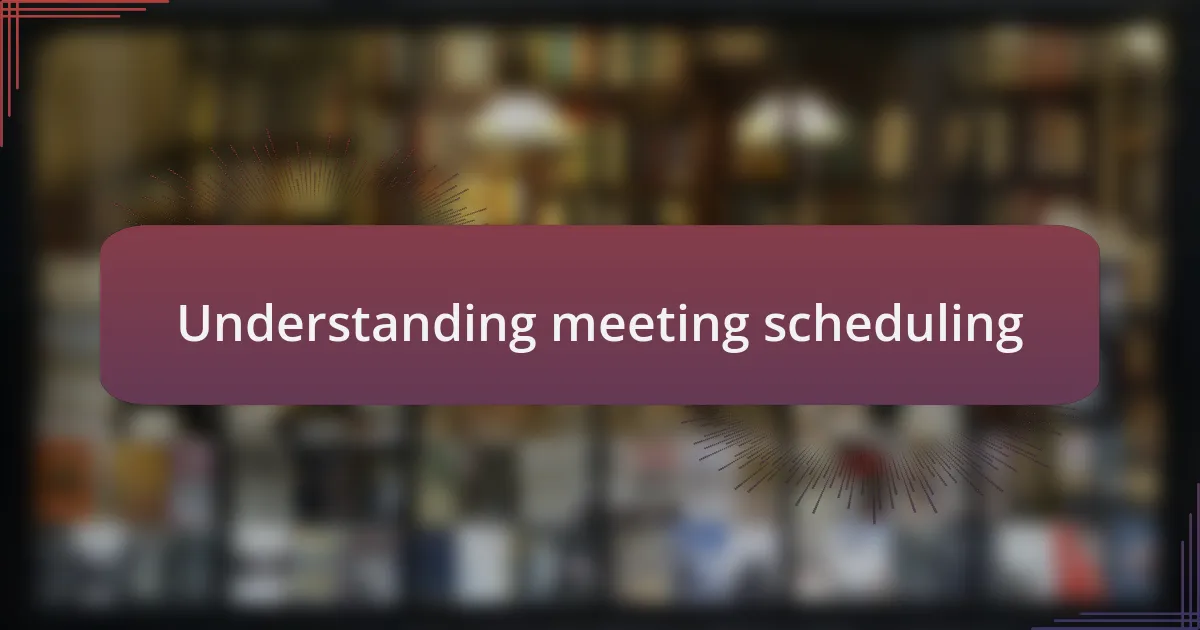
Understanding meeting scheduling
Meeting scheduling can often feel like a chess game—strategic but sometimes overwhelming. I remember a time when I was juggling multiple meeting requests and realized that clarity is essential. Setting clear objectives for each meeting not only helps in efficient scheduling but also ensures that everyone remains focused and engaged.
Have you ever found yourself double-booked and scrambling to find a solution? It’s a common experience that can be alleviated by using scheduling tools. I’ve learned that using platforms like Google Calendar or scheduling apps can help streamline the process, allowing you to see everyone’s availability at a glance, which saves time and reduces the stress of finding a common time.
One lesson that stands out to me is the importance of considering your team’s preferences. I often take a moment to ask my colleagues about their preferred meeting times or formats. This small gesture fosters a sense of inclusivity and makes the scheduling process less of a chore; it transforms it into a collaborative experience that everyone values. How often do we stop to think about the people on the other side of the calendar invite?
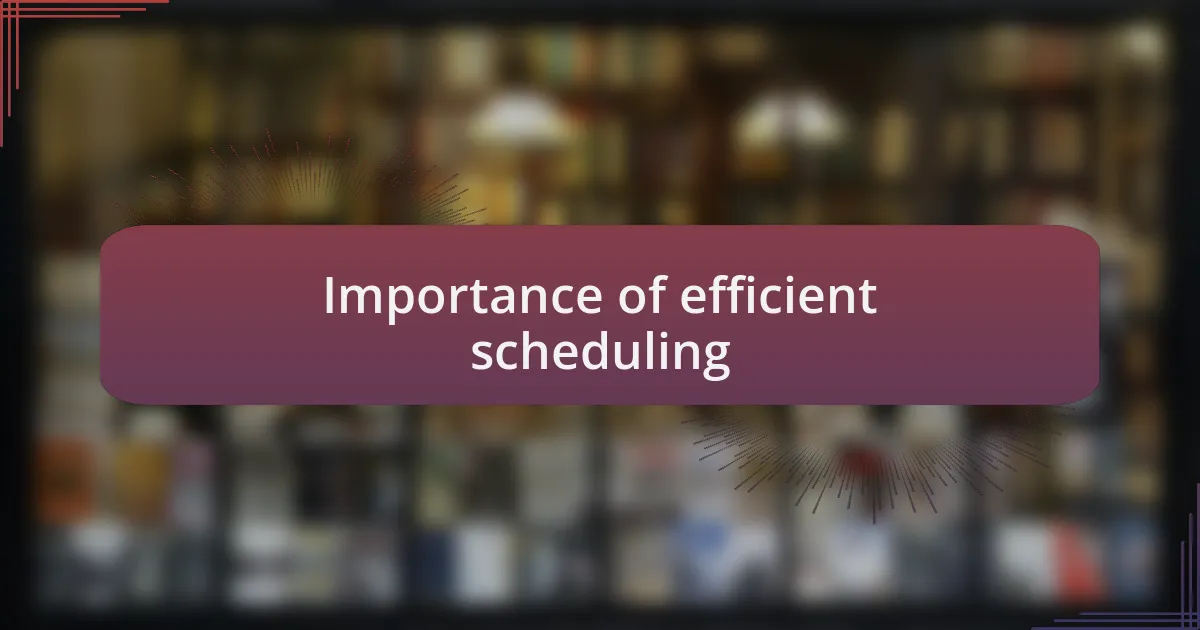
Importance of efficient scheduling
Efficient scheduling is crucial because it directly impacts productivity. I’ve often found that meetings can quickly derail without proper time management. One time, a poorly scheduled meeting ran over, causing a domino effect on the rest of my day. Have you ever felt that frustration? It’s like sinking into quicksand—once you’re stuck, getting back on track becomes a formidable challenge.
Think about how efficient scheduling can enhance team dynamics. Early in my career, I noticed that uncoordinated meeting times led to missed opportunities for collaboration. When I started prioritizing scheduling efficiency, not only did we decrease the number of conflicts, but the quality of our interactions skyrocketed. It’s surprising how a well-timed meeting can invigorate discussions and drive creativity.
Moreover, clear scheduling helps manage expectations. I remember a particularly chaotic project where unclear meeting times resulted in confusion about roles and deliverables. By implementing a simple scheduling template, everyone knew when to prepare for discussions. This not only reduced anxiety but built a stronger sense of accountability among team members. Have you tried similar strategies to improve clarity in your team meetings?
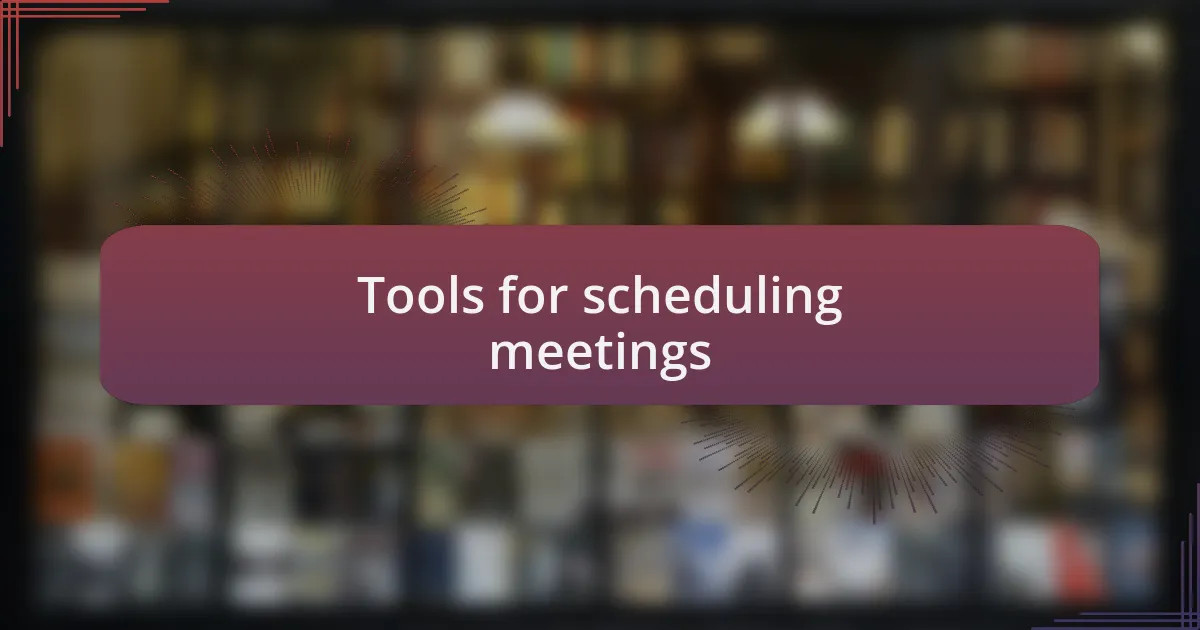
Tools for scheduling meetings
Scheduling meetings can be streamlined with a variety of tools that cater to different needs. I’ve personally found apps like Calendly and Doodle to be game-changers in my workflow. With their user-friendly interfaces, I can easily set my availability and allow others to pick slots that work for them, eliminating the back-and-forth email chains. Have you ever experienced that endless search for a common meeting time? It’s far too tedious!
As for project management tools, I’ve seen tremendous benefits from integrating scheduling features within platforms like Asana or Trello. When I attach meeting links directly to task cards, it creates a seamless connection between tasks and discussions. This approach not only keeps everyone organized but also ensures that the team is consistently aligned on goals as we progress. Isn’t it reassuring to have everything correlated in one place?
Another tool that I’ve come to appreciate is Google Calendar. It’s astonishing how a simple calendar can transform the way I approach my day. With the ability to share my calendar with colleagues, we can avoid double-booking and ensure that important meetings are prioritized. Plus, the reminders help keep me on track—who wouldn’t want a little nudge to prepare before a meeting?
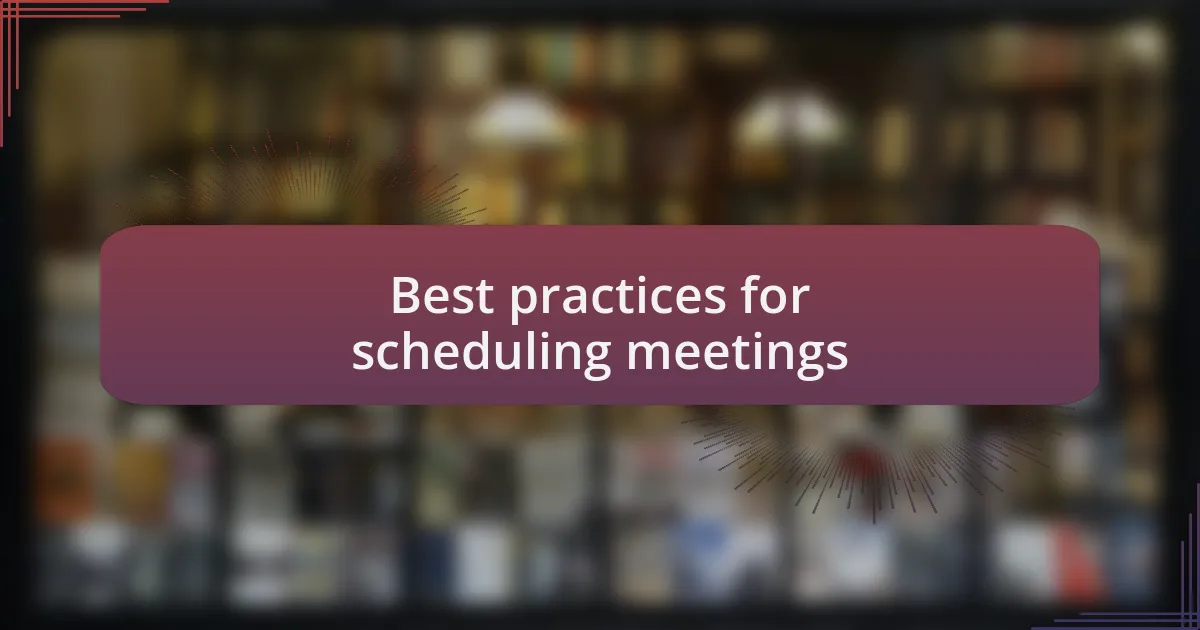
Best practices for scheduling meetings
When scheduling meetings, it’s essential to consider the participants’ time zones, especially in our increasingly globalized world. I remember a time when I unwittingly scheduled a meeting at 8 AM my time, thinking everyone would be awake. Little did I know, it was the middle of the night for others. Since then, I always double-check time zones, and I encourage others to do the same. How many times have you found yourself scrambling to accommodate a last-minute time change?
Another critical practice is to set a clear agenda before any meeting. I can’t stress enough how transformative this has been for my meetings. I often send out an outline of discussion points, which not only keeps the meeting focused but also allows everyone to come prepared. Have you ever felt lost in a meeting with no clear direction? Having an agenda turns what could be a chaotic discussion into a structured conversation.
Finally, I’ve learned the value of keeping meetings concise. It’s tempting to dive into every detail when discussing projects, but I’ve found that aiming for shorter, focused meetings tends to spark more creativity and engagement. For instance, I try to cap meetings at 30 minutes to encourage prompt discussions. Have you noticed how easy it is to lose momentum in longer meetings? Keeping it brief can make a world of difference in maintaining energy and productivity.
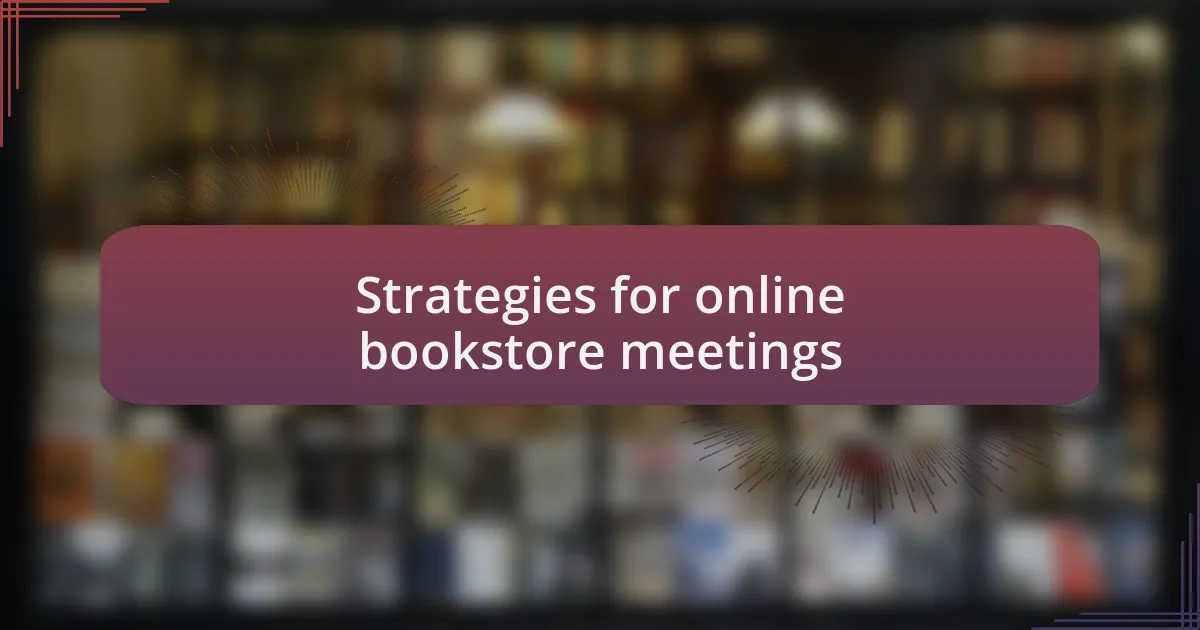
Strategies for online bookstore meetings
One strategy I find particularly effective for online bookstore meetings is utilizing collaborative tools. For example, tools like Google Docs or Trello have transformed how I gather ideas and feedback before we even meet. When team members can input their thoughts in real-time, it sparks ideas and builds a sense of ownership, which enhances our discussions. Have you ever thought about how much more productive a meeting can be when everyone comes in already aligned with the discussion?
Another approach I often adopt is staggering meeting times for different teams. Let’s be honest—in a creative environment like an online bookstore, not all teams need to meet simultaneously. By scheduling separate sessions for marketing, inventory, and customer service, I allow each department to dive deep into their own challenges without feeling rushed. It’s moments like these that lead to breakthroughs. Have you noticed how often interdepartmental meetings can lead to one team dominating the conversation while others sit back?
Lastly, I emphasize the importance of follow-up after meetings. I’ve learned the hard way that simply holding a meeting isn’t enough. Sending out a summary of what was discussed, action items, and deadlines often holds everyone accountable and keeps the momentum going. I can’t tell you how rewarding it is when I see progress happening simply because I took a moment to recap what we talked about. Isn’t it fascinating how simple practices can significantly boost productivity?
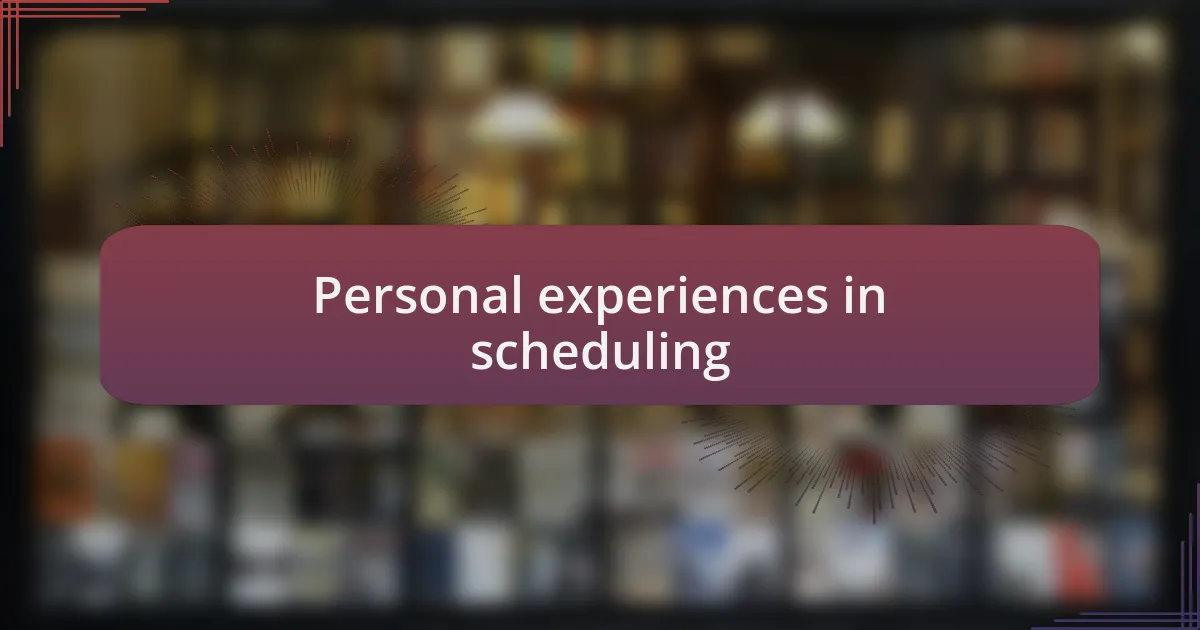
Personal experiences in scheduling
When I first started scheduling meetings for my online bookstore, I underestimated the importance of timing. I vividly recall a day when I scheduled a brainstorming session just before a major release. The energy was palpable, but I could see team members struggling to focus; they were preoccupied with last-minute tasks. I learned that finding a balance between urgency and availability can dramatically impact the effectiveness of a meeting. Have you ever noticed how crucial the right timing is?
There was a time when I tried to accommodate everyone’s schedules and ended up with a patchwork of availability. It felt chaotic, and the quality of our discussions suffered because participants were distracted or exhausted from constant rescheduling. This experience taught me that prioritizing quality over quantity is essential. Now, I’m much more selective about who needs to be present at each meeting, ensuring that the right voices contribute to the conversation. What have you experienced in terms of juggling different priorities during scheduling?
One of my most significant lessons came from a simple miscommunication about a meeting’s agenda. I remember arriving at a session only to find that half the team was unprepared, having misunderstood the objectives. That moment underscored the importance of clarity in scheduling. Now, I make it a point to not only share agenda items in advance but also to engage the team in co-creating those agendas. It’s incredible how a little preparation can turn a potential disaster into a collaborative triumph. Don’t you feel that shared understanding elevates the entire discussion?
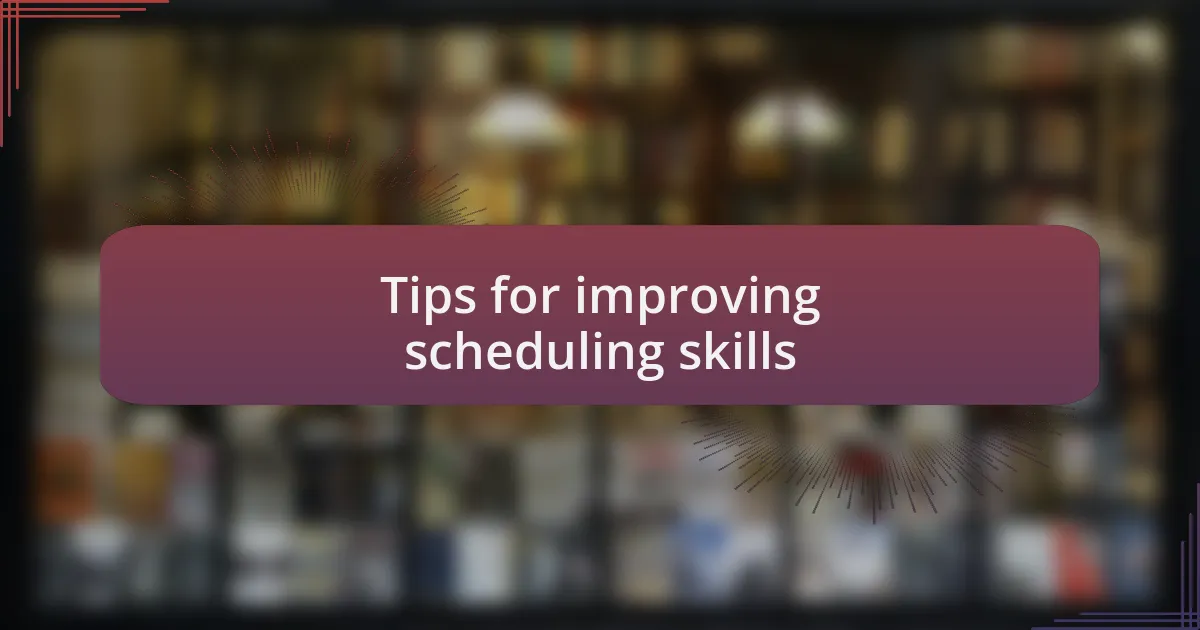
Tips for improving scheduling skills
When it comes to improving scheduling skills, I’ve found that blocking time for specific tasks on my calendar can be a game changer. I once had a chaotic week filled with back-to-back meetings, leaving me drained and unproductive. Now, I allocate blocks of time for deep work and reflection, allowing me to recharge and approach each meeting with fresh energy. Have you tried this approach? It can transform the way you engage in discussions.
Another tip I’ve learned is the power of setting clear deadlines for responses. Early in my journey, I would wait indefinitely for team members to confirm their availability, which led to frustrating delays. By establishing a firm but reasonable deadline for feedback, I’ve streamlined the scheduling process, reducing uncertainty and keeping everyone accountable. It’s amazing how this simple change can create a sense of urgency without pressure, don’t you think?
Lastly, I highly recommend incorporating digital tools to enhance scheduling efficiency. I once struggled to keep track of all the moving parts involved in organizing meetings, but since I started using scheduling apps, the process has become so much smoother. These tools not only help in finding optimal times for everyone but often send reminders, which I appreciate. Have you considered using technology to simplify your scheduling tasks? It can really make a difference in staying organized and focused.